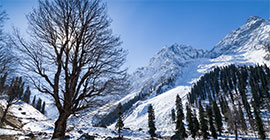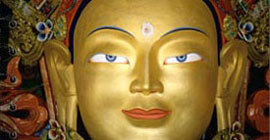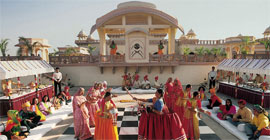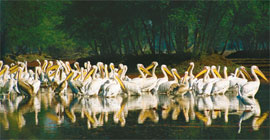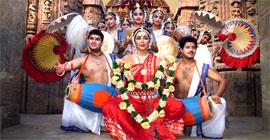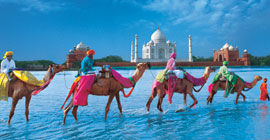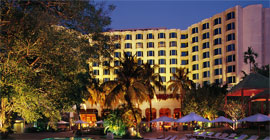Guwahati
Home | Guwahati
Guwahati is a major city in eastern India, often considered as the gateway to the North-East Region (NER) of the country and is the largest city within the region. Dispur, the capital of the Indian state of Assam is situated within the city. Guwahati is one of the most rapidly growing cities in India. During past few decades it has experienced unprecedented spatial expansion and also steep rise in population. In fact according to a survey done by a UK media, Guwahati is among the first 100 fastest growing city of the world and is 5th fastest growing among Indian cities. Today, the city straddles between the LGB International Airport in the west to Narengi in the east for almost 45 kilometres and between the southern bank of the Brahmaputra river and the foothills of the Shillong plateau for around 15 kilometres. Moreover, the city is also getting gradually expanded to the northern bank of Brahmaputra.
Guwahati is also one of the most beautiful cities in South Asia with the mighty and picturesque Brahmaputra, river islands (e.g. Umananda), beaches, beach-islands (balicapori), thick tropical green cover, natural sweetwater lakes, hills with thick forests and with beautiful and lively native population.
Digholy Pukhury, Guwahati
In the medieval times, after weakening and destruction of the Kamata kingdom between the 12-15th century AD, the city lost its earlier glory and became only a strategic outpost of the then Koch Hajo and Ahom Kingdoms of western and eastern Assam. Later the western part of the Koch Kingdom fell to the Mughals and the eastern half became an Ahom protectorate. Although the actual border between both the powers (Ahoms and Mughals) kept fluctuating between Kartoya river (now in North Bengal) to Manas river and Barnadi river time to time, Guwahati became the actual war-front (as the outpost of importance).
The city was the seat of the Borphukan, the civil and military authority of the lower Assam region appointed by the Ahom kings. The Borphukan's residence was in the present Fansi Bazaar area, and his council-hall, called Dopdar, was situated about 300 yards (270 m) to the west of the Bharalu stream. The Majindar Baruah, the personal secretary of the Borphukan, had his residence in the present-day Deputy Commissioner's residence (Baruah 1992:200-201).
Mughals attacked Assam for 17 times and many a times temporarily Guwahati fell to them. The Battle of Saraighat fought close to Guwahati in 1671 is the most famous and known war, in which the Mughals faced severe defeat due to strong leadership of Lachit Borphukan and hard work of Assamese Army.
There are a number of historic features in Guwahati. The Dighali Pukhuri is a rectangular lake that was connected to the Brahmaputra, and was an ancient boat yard, which was probably also used by the Ahoms in the medieval times. Moreover, there are many tanks, temples, ramparts, etc. in the city. The most important archaeological site is the Ambari excavation site close to Digholy Pukhury.
Natural environment
Bor-Sola Beel, Guwahati
Geomorphologically, the city is located in an area, where the Shillong Plateau and the Floodplains of the Brahmaputra confront each other. Landforms within the city are therefore unique with dissected hills (originally part of the Shillong Plateau), plain areas and natural lakes (the beels), swamps and the mighty river Brahmaputra.
The main city is situated on the southern bank of the Brahmaputra. At places the width of the river is 6 to 8 km, while its narrowest portion (1.8 km) is in the location of the famous bridge of Saraighat. There are many permanent and temporary islands and beaches in the river. Umananda a permanent island situated close to the city-center provides a unique picturesque environment. The natural drainage system consist of the Bharalu River (a tributary - the Brahmaputra) and its inter-linkages to the beels and to the Brahmaputra river. Apart from Bharalu, many small rivers Morabharalu, Bahini, and Basista flow within the city interconnected with the feeder drains of the city.
There are numerous beels spread throughout the city, which largely contribute to aesthetic and natural environments.Deepor Beel, a Ramsar Convention list wetland of international importance, the only such large water reserve of Guwahati adds to its close relation with nature. It is a famous site for the bird fans after being declared a bird sanctuary by the officials. Other water bodies/wetland within the city are Soru Sola Beel and Bor Sola Beel. The Bor-Sola Beel, which about four times the length of Dighalipukhuri, stretches from behind the Meghadoot Cinema hall and the Nepali Mandir in the Paltan Bazaar locality in the north end to Sarabhatti locality in the south end and is the biggest water body within the city.
There are several hills of different sizes and shapes. The hills in the northern areas (Nilachal or Kamakhya Hill in the north-west, Chitrasala or Kharghuli Hill in the north) close to the bank of Brahmaputra, south-central areas (Narakasur Hill, Kalapahar and Fatasil Hill) and eastern areas (Narengi, Hengerabari, etc) have in fact guided Guwahati's development in three elongated corridors limiting to the plain areas. Many of these hills such as the Nilachal, Chitrachal, Narakasur, etc. are famous of their legendary, religious and historic importance.
Places of interests
Guwahati possesses many places of interests with lively urban activities, ancient temples, attractive natural features (apart from the Brahmaputra river) and with recreational activities. Guwahati is also situated at the center of an attractive region (within 200 km radius) with natural parks, wildlife sanctuaries, hill stations of different types and with a colourful cultural landscape.
Urban attractions
There are several interesting and lively places in the city. These areas provide the city with hotels, restaurants, shopping and business areas. The most lively part is the city center. Momos and chicken rolls are popular fast food available almost in every restaurant. Moreover, there several good restaurants offering Indian, South Indian, traditional Assamese, Chinese and continental food. There are also several good book shops and music stores. Few of these lively areas in the city are:
Brahmaputra with Ferry; Fancy Bazaar
Pan Bazaar: A lively part of the city center on the southern bank of the Brahmaputra. Cotton , Digholy Pukhury (Dighali Pukhuri), The State Museum, RBI, District Court (Kamrup District), etc. are major landmarks. Moreover, the area also possesses many libraries, major government offices and a shopping district. Restaurants and bookshops in the area provide a unique environment. It is also a major wholesale market for drugs and pharmaceutical products and a hub for printing and publication. Close to Digholy Pukhury, there are many stores with traditional arts and crafts from Assam and other parts of the NER. Kacari Ghat, next to the district court is an important local river port.
Fancy Bazaar: Situated in the western part of the city-center is a busy commercial district for both wholesale and retail. Fansi Bazaar is the hub for various wholesale products ranging from food and beverages, garments to hardware and building materials. It is also known for the retail shopping areas for clothes and garments.
(because of the existence of a district jail, hangings used to take place here during the British regime, which is responsible for the prefix 'Phasi', i.e., hanging, that later got mispronounced as 'Fancy')
Paltan Bazaar: In the central part of the city-center is the hub for transportation and hotels. With Guwahati railway station, the regional bus stand (ASTC), numerous hotels, restaurants and offices and stops of numerous private bus service (regional) providers, the area is the busiest and congested. There are also many small shops selling traditional garments from various parts of the NER.
Ganeshguri: Is a newly developed commercial node in the south outside the city-center. Its proximity to the state capital complex and rapidly growing southern residential areas have made it an important sub-city-center. Ganeshguri is a busy part of the city with retail shopping areas, hotels and restaurants and small businesses.
Beltola Bazaar: Is a traditional weekly fruits and vegetables market with historic importance. The market exisists since historic past and is an important traditional trading point between the people from the Khasi hills (Meghalaya) and local people. It is a rich market with various types of local food products. It is located in Beltola, a predominantly residential area in the south.
Other attractions
The key attractions are:Urban Attractions Art & Culture Ancient & Historic Others
Fansi Bazaar Shankardev Kalakhetra Uma Nanda Temple Accoland
Paltan Bazaar Jyoticitrobon Basistha Temple Guwahati Planetarium
Ganeshguri Guwahati Book Fair Navagraha Temple Nehru Stadium
BeltolaBazaar NEDFi Haat Sukreswar Temple Digholy Pukhury
Zoo Road Assam Forest Museum Digheswari Temple Narengi Golf Club
Pandu Lokenath Temple, Loco Colony, Pandu Rudreswar Temple
Rest Camp Kalibari Ugra Tara Temple
Hajo Pandu Port
Garchuk Lachit Garh
Regional attractions
Guwahati is also located centrally to many of the regional tourist destinations and the city provides basic communication services and tours to access these. Few of these are:
Kaziranga National Park - 200 km east, famous for one horned rhinoceros
Pobitora Wildlife Sanctuary - 60 km east
Shillong - 100 km south, a beautiful hill station and the capital city of Meghalaya surrounded by pine forests
Tawang - 200 km north, a famous Buddhist monastery in the snow-clad Arunachal-Himalayas
Manah / Manas National Park - 150 km west, a beautiful wildlife sanctuary in the foot hills of Himalaya
Moreover, there are several wonderful picnic spots (e.g. Candubi) in and around the city.
Hundreds of traditional Oxomeeya (Assamese), Bodo, Karbi, Tiwa, Garo, Khasi villages and traditional way of life in 200 km radius of the city can be of great interests to tourist. Bamboo and fruit orchards, handloom and handicraft, wet paddy fields, fishing, etc. are typical characteristics of local traditional way of life. Xorthebary and Xualkuchi are two places near the city with tradition of bronze-crafts and silk weaving for thousands of years.
Madan Kamdev, at 35 km from the city is an important archeological site with ancient ruins of temples and other structures.
Hajo and the sacred place of Hayagriba Madhava are two important religious places both for the Hindus and the Buddhists. One of the temples, which is known as the Haygriba Madhava temple is a Bishnu temple for the Hindus and at the same time an important shrine for the Tibetan Buddhists. The Buddhists believe that the Buddha attained nirvana at this place. The temple was destroyed by Kalapahar and was rebuilt by the Koch king Raghudev in 1543. Another temple in proximity was built by the Ahom king Pramatta Singha, where 'doul' - a grand religious festival is celebrated every year. There is a large pond with a giant turtle close to the temple. Puwa Macca in Hajo is an important religious place for Muslims with a mosque built in 1657 during the time of Mughal's invasion.







